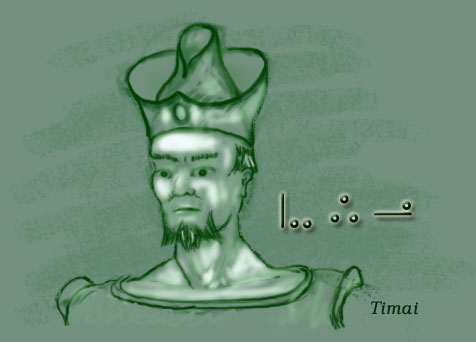
Axuna intervened on the winning side in a few wars (825, 830, 847), and was rewarded each time with territory. By 850 the lower Xengi was entirely under the control of its king, Tazipivu. This position proved strong enough to serve as the basis for the conquest of most of the rest of the Xengi plain, under Tima (asc. 855). By 890 he was lord of almost all of the Axunaic-speaking areas. In celebration he added the augmentive suffix -i to his name, his title, and his realm, moving from nive of Axuna to the exalted status of niveï of Axunai.

Timai’s son Uliromez finished off a few more Jeori principalities, and established a toehold on the Mnau peninsula (901). Neičunimi conquered Gotanneli in 920, only to lose it in 925.
The state of Meuneli is the most spectacular result of a series of barbarian migrations triggered by the Jeori conquest of Bolon. The Čia-Ša first tried to move west into the Barbarian Plain, only to incite a counter-invasion by the Bucair and Sainor (both Karazi peoples). Jeori disunion provided the opportunity to take over a large and rich swath of territory.
Eŋŋuḷoşum now made his own bid for empire, supporting Iṭili in its rebellion against Engidori. He whupped Engidori and Papliopagimi— but then was assassinated, in 807.
The rise of Axunai made the Skourenes nervous. The colonial city of Kuliŋibor established the Mudric Confederacy (Muḍureg), which the Kuliŋiboriki righteously insisted was a confederation, not an empire. Tima validated their fears by actually invading the Littoral in 885; he was soon defeated.
(See the Historical Atlas of Skouras for further details.)
A generation passed with no further excitements; the cities of the Confederacy grew restive. The easiest solution was an external enemy, namely Guṭḷeli and its ally Miligenḍi. This war was won by 938, giving the Confederacy control over almost the whole Skourene sphere. As a sign of respect, the Šinourene heartland plus Guṭḷeli was organized as the Skourene League, which enjoyed some internal autonomy. Only Engidori, Papliopagimi, Śiḍḍi, Peligi, Gurdago and some of the other far colonies of Guṭḷeli, and the states of Feináe have escaped the benefits of Mudric rule.
The Enevi clan has extended its power over the upper Lenani steppe. Enev means ‘priest’; the clan had a special religious authority which it parlayed into political dominance.
Araunicoros, however, is winning the race to the mountains. The recapture of the lake of the gods, Como, was a boost to the cause (832).
Cayenas fought its way to the ocean, and there found it more profitable to fight the trade-rich Monkhayu than the Munkhâshi. In the course of the last century they took over Koto, the richest part of Davrio, and the mouth of the Serea. The adventurers’ ties to the home country were never very strong, and the latter territory, Tel Neuor, was effectively independent by 920.
Cuzei continues in its malaise. Unity can no longer be maintained (Lānavo separated from Cuzei in 814, Aure Árrasex in 890), and the worship of Iáinos, once universal, is now threatened by newfangled innovations— pantheism, atheism, even paganism. The last pages of the Book of Eleď are filled with the prophets’ warnings to repent or suffer the wrath of God.